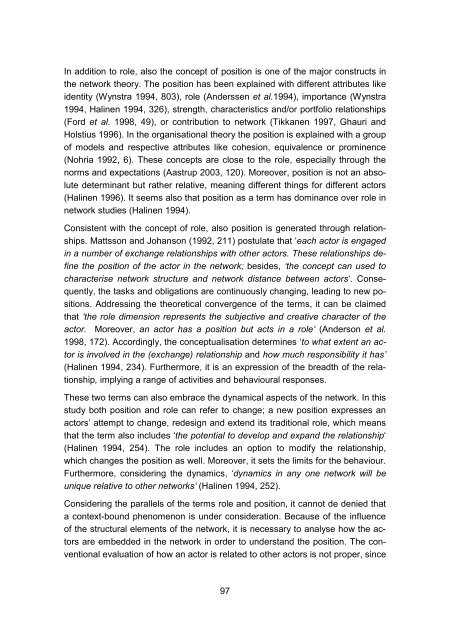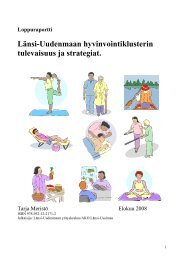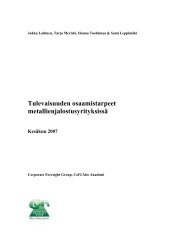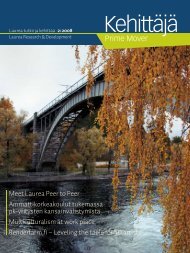849954 sisus
849954 sisus
849954 sisus
You also want an ePaper? Increase the reach of your titles
YUMPU automatically turns print PDFs into web optimized ePapers that Google loves.
In addition to role, also the concept of position is one of the major constructs in<br />
the network theory. The position has been explained with different attributes like<br />
identity (Wynstra 1994, 803), role (Anderssen et al.1994), importance (Wynstra<br />
1994, Halinen 1994, 326), strength, characteristics and/or portfolio relationships<br />
(Ford et al. 1998, 49), or contribution to network (Tikkanen 1997, Ghauri and<br />
Holstius 1996). In the organisational theory the position is explained with a group<br />
of models and respective attributes like cohesion, equivalence or prominence<br />
(Nohria 1992, 6). These concepts are close to the role, especially through the<br />
norms and expectations (Aastrup 2003, 120). Moreover, position is not an absolute<br />
determinant but rather relative, meaning different things for different actors<br />
(Halinen 1996). It seems also that position as a term has dominance over role in<br />
network studies (Halinen 1994).<br />
Consistent with the concept of role, also position is generated through relationships.<br />
Mattsson and Johanson (1992, 211) postulate that ‘each actor is engaged<br />
in a number of exchange relationships with other actors. These relationships define<br />
the position of the actor in the network; besides, ‘the concept can used to<br />
characterise network structure and network distance between actors‘. Consequently,<br />
the tasks and obligations are continuously changing, leading to new positions.<br />
Addressing the theoretical convergence of the terms, it can be claimed<br />
that ‘the role dimension represents the subjective and creative character of the<br />
actor. Moreover, an actor has a position but acts in a role‘ (Anderson et al.<br />
1998, 172). Accordingly, the conceptualisation determines ‘to what extent an actor<br />
is involved in the (exchange) relationship and how much responsibility it has’<br />
(Halinen 1994, 234). Furthermore, it is an expression of the breadth of the relationship,<br />
implying a range of activities and behavioural responses.<br />
These two terms can also embrace the dynamical aspects of the network. In this<br />
study both position and role can refer to change; a new position expresses an<br />
actors’ attempt to change, redesign and extend its traditional role, which means<br />
that the term also includes ‘the potential to develop and expand the relationship‘<br />
(Halinen 1994, 254). The role includes an option to modify the relationship,<br />
which changes the position as well. Moreover, it sets the limits for the behaviour.<br />
Furthermore, considering the dynamics, ‘dynamics in any one network will be<br />
unique relative to other networks‘ (Halinen 1994, 252).<br />
Considering the parallels of the terms role and position, it cannot de denied that<br />
a context-bound phenomenon is under consideration. Because of the influence<br />
of the structural elements of the network, it is necessary to analyse how the actors<br />
are embedded in the network in order to understand the position. The conventional<br />
evaluation of how an actor is related to other actors is not proper, since<br />
97








